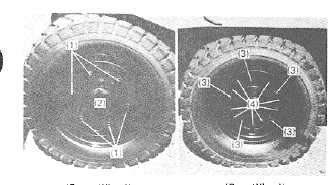| |
TM 10-3930-653-14&P
[3] TIRE INFLATION PRESSURE CHECK
Check condition of tires. Low air pressure reduces tire
service life and increases fuel consumption. Uneveness
of air pressure between right and left tires or unevenly
worn or badly damaged tires will cause uneven steering
forces.
< Inflation Pressure >
kg/cm2 (psi)
Sinqle Drive Wheels ..........................................8,5 (120)
Steering Wheels ...................................................7 (100)
Turn the tire valve cap counterclockwise and remove it.
Using a tire pressure gauge, measure the inflation
pressure, and adjust it to the specified pressure, if
needed. After making sure there is no air leakage from
the tire valve, reinstall the cap.
Check that each tire does not get damaged at the tread
surface or side face or there is no bending at the rim,
Since the forklift truck needs tires that have a high
inflation pressure to carry heavy loads, even a small
bending of rims or damage at the tread surface could
cause an accident. If the operator finds any defect on
the tires, consult TCM’s dealer or distributor.
WARNING
All nuts and bolts should be properly installed and
torqued before inflating tire and rim assembly, An inflated
tire contains potentially explosive energy.
DON’T OVERINFALTE.
WARNING
When using an air compressor, first adjust the air
pressure of the compressor. Failure to do so will cause
a serious accident, since the compressor delivers the
maximum pressure.
[4] HUB NUT TORQUE CHECK
Check hub nuts for correct torque. All hub nuts should
be tightened to the specified torque securely.
(1) Front Wheel Hub Nut.......................... 39 to 45 kg-m
(282 to 325 ft-lbs)
(2) Drive Shaft Nut .................................. 7.8 to 9.0 kg-m
(56 to 65 ft-lbs)
(3) Rear Wheel Hub Nut ........................... 39 to 45 kg-m
(282 to 325 ft-lbs)
(4) Rear Wheel Divided Rim Nut........... ..6.6 to 7.6 kg-m
(48 to 55 ft-lbs)
(Front Wheel) (Rear Wheel)
WARNING
• When removing tire assembly from the truck, remove
only HUB NUTS 3. Never loosen split type wheel nuts
4before deflating tires.
• Completely deflate tires before removing split type
wheel nuts 4,
• Tires with split wheels should be inflated in a safety
cage or when properly Installed on the truck In either
case, make sure all nuts and bolts are properly Installed
and torqued as specified
• If wheel nuts on the drive axle are loose, tighten nuts to
specified torque after removing tire and wheel assembly
from the truck.
• Tires with lock ring type wheels should be Inflated in a
safety cage or with attaching safety chain
• Stop the truck on a level, hard surface and shut down
the engine. All loads should be unloaded from the
truck.
• Apply the parking brake and block the wheels. Put the
jack under the truck frame.
• Jack up the truck to the extent that the tire still remains
on the ground. Loosen the hub nuts Do not remove
them.
• Again jack up the truck until the tire leaves off the
ground. Remove the hub nuts, and detach the wheel.
• The wheel should be reinstalled in the reverse order
The hub nuts should be tightened in the diagonal order
evenly.
2-9
|



